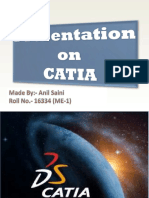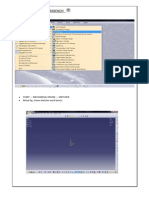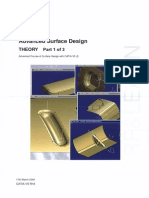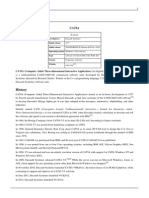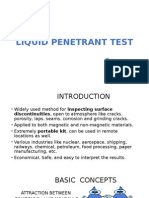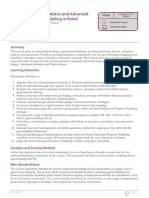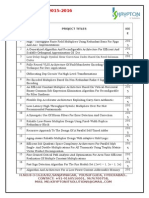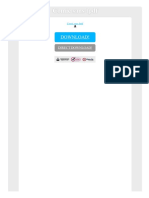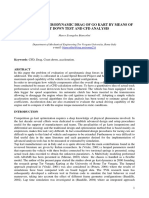CATIA V5 Lectures
CATIA V5 Lectures
Uploaded by
Murali AnirudhCopyright:
Available Formats
CATIA V5 Lectures
CATIA V5 Lectures
Uploaded by
Murali AnirudhOriginal Title
Copyright
Available Formats
Share this document
Did you find this document useful?
Is this content inappropriate?
Copyright:
Available Formats
CATIA V5 Lectures
CATIA V5 Lectures
Uploaded by
Murali AnirudhCopyright:
Available Formats
CATIA V5
Dr Ahmed Kovacevic
City University London
School of Engineering and Mathematical Sciences
Room CM124, Phone: 8780, E-Mail: Design@city.ac.uk
www.city-design.tk
www.staff.city.ac.uk/~ra600/intro.htm
Course Schedule
Lecture 1
Introduction
Software Overview
Part Design and Sketching
Lecture 2
Product Structure and
Assembly Modelling
More advance Part Design
Lecture 3
Wireframe and Surface
Drafting
Lecture 4
Finite Element Analysis
Data Exchange
Parameters and Formulas
Lecture 1
CATIA Overview
CATIA v5 is an Integrated Computer Aided
Engineering tool:
Incorporates CAD, CAM, CAE, and other applications
Completely re-written since CATIA v4 and still under development
CATIA v5 is a native Windows application
User friendly icon based graphical user interface
Based on Variational/ Parametric technology
Encourages design flexibility and design reuse
Supports Knowledge Based Design
Lecture 1
CATIA v5 Philosophy
A Flexible Modelling environment
Ability to easily modify models, and implement design changes
Support for data sharing, and data reuse
Knowledge enabled
Capture of design constraints, and design intent as well as final
model geometry
Management of non-geometric as well as geometric design
information
The 3D Part is the Master Model
Drawings, Assemblies and Analyses are associative to the 3D
parts. If the part design changes, the downstream models with
change too.
Lecture 1
CATIA v5 Applications
Product Structure
Part Design
Assembly Design
Sketcher
Drafting (Interactive and
Generative)
Wireframe and Surface
Freestyle Shaper
Digital Shape Editor
Knowledgeware
Photo Studio
4D Navigator (including
kinematics)
Manufacturing
Finite Element Analysis
Lecture 1
CATIA User Interface
Current
Application
Menu Bar
Online Help
File Toolbar
Application
Tool Bar
View Toolbar
Lecture 1
Interacting with CATIA (1)
Selecting an Application
Use the Start menu to select an
application
Working with Files
Use the File menu to create,
open, save and print
Lecture 1
Interacting with CATIA (2)
Display Commands
Fly Through
Fit View
Layer control
Pan
Rotate
Zoom
Normal View
Standard Views
View Types: Shaded/ Hidden
Line/ Wireframe/ User Defined
Hide/ Show
Hide
Swap Visible Space
Properties
Display Characteristics for an
object are set by selecting the
entity, then pressing the right
mouse button and selecting
Properties from the menu
Lecture 1
Manipulating the Display using the Mouse
Pan
Using the compass
Drag the axes or planes of
the compass to dynamically
rotate the display
Multi-select entities by
holding down the Shift key
Press and hold the middle
mouse button and move the
mouse to pan
Rotate
Press and hold the middle
mouse button then the left
mouse button and move the
mouse to rotate
Zoom
Press and hold the middle
mouse button and click the left
mouse button then move the
mouse to zoom in and out
Lecture 1
More Common Commands
Copy/ Paste
Geometry entities can be
copied and pasted from one
part to another.
Paste Special allows you to:
Paste a complete copy with
history
Paste a linked copy
Paste the result without
linking
Undo/ Redo
Allows you to undo previous
actions
Redo repeats an action that has
been undone
Hide/ Show
Allows you to temporarily hide
entities from the display
Hidden entities can be
recovered by clicking on the
Swap visible space icon, and
then selecting the entity to
make visible
Update
Used to update the part after
modification
Lecture 1
The Specification Tree
The Specification Tree is displayed on the
left side of the screen while you are
working
Provides access to the history of how a
part was constructed, and shows the
product structure
Product entities can be selected from the
spec. tree or in the geometry area
Parts can be modified by selecting them
from the spec. tree.
Click on + to open a tree branch
Solid Parts are stored in the PartBody
branch of the Part tree
Lecture 1
Getting Help
The online help library can be accessed by selecting
the Help -> Contents, Index and Search command
The Help home page provides a search facility, and
allows you to browse by application.
Every CATIA task has a getting started guide
Lecture 1
Getting Help from the CATIA
Community
For general information about CATIA from IBM and Dassault
Systemes refer to:
www.catia.com
For access to the database of known problems refer to:
http://service.boulder.ibm.com/support/catia.support/databases
The CATIA operators exchange provides a forum for the
exchange of ideas and advice about using CATIA at:
www.coe.org
And look at Member Center -> Forum
Lecture 1
Part Design
The Part Design application is used to create solid
models of parts
Solid parts are usually created from 2D profiles that
are extruded or revolved to form a base feature
The Part Design task is tightly integrated with a 2D
sketching tool
A library of features is provided to allow user to add
additional details to a base part
Parts can be modified by selecting their features in
the specification tree
Parts are stored in files with the extension .CATPart
Lecture 1
Part Design
Pad
Pocket
Shaft
Base Features
Slot
Hole
Groove
Dress-up Features
Fillets
Chamfers
Transformation Features
Reference Elements
Point
Line
Plane
Draft Shell
Thickness
Translation
Rotation
Mirror
Pattern
Scale
Lecture 1
Sketcher
The sketcher is used to create 2D sketches of
designs, and apply constraints to the sketched
geometry
The sketcher is now the main environment for
developing 2D profiles that will be used to build solid
models (but traditional 2D wireframe techniques are
available in the Wireframe and Surface application)
The sketcher provides a flexible environment for
creating and modifying 2D geometry
Lecture 1
Sketcher
Entering the sketcher
Click on the Sketcher icon or
select Start -> Mechanical
Design -> Sketcher
Exiting from the Sketcher
Click on the Exit icon to leave
the sketcher and return to the
3D workspace
Geometry Operations
Constraint Creation
Tools Toolbar
Geometry Creation
Snap to point
Construction Geometry
Constraint
Lecture 1
Using the Sketcher
The Sketcher is a parametric design tool
It allows you to quickly draw the approximate shape
of a design, and then assign constraints to complete
the shape definition
Constraints can be applied as:
Driving Dimensions dimensions that control
the size of a geometric entity
Geometric Constraints geometric
relationships such as parallel, perpendicular,
tangent, collinear
Lecture 1
Sketching Example
1.
2.
3.
Click on the Sketcher icon
Select the 2D plane to sketch
on (may be a plane, or the face
of an existing part), and the
sketching window will appear
Sketch the profile
4. Apply constraints to define the
exact geometry required
4. Click on the exit icon to quit the
sketcher
5. Sketch is transferred into the
3D modelling environment
Lecture 1
Sketching Tips
To edit an existing sketch ensure that you select the sketch from
the specification tree, or select an element in the sketch. (If you
do not do this you will create a new sketch instead of modifying
the existing one)
If the sketch goes purple while you are constraining it is overconstrained. Generally it is best to Undo the last constraint and
examine existing constraints to find the problem before
continuing
Solids can only be created from sketches that form a single
closed boundary
The profile icon allows you to create complicated profiles
including lines and arcs. See the online help for more
information
Lecture 1
Creating a Solid Part from a Sketch
1. Click on the Pad icon to
create an extruded part
2. Select the sketch containing
the profile you want to
extrude (note the sketch is
treated as a single entity)
3. The Pad definition window
will appear
4. Select the limit type from:
Dimension
Up To Next
Up To Last
Up To Plane
5. Type in the length if required
6. Check the extrude direction
arrow
7. Click on OK to create the
Part
Lecture 1
Working with Features
The Part Design task uses intelligent design features
The features contain information about their context as well as
their shape
For example a Hole feature can only be created once you have
created a part body
A hole feature requires an attachment face, and driving dimensions
A hole is a negative feature it is automatically subtracted from the main
Part Body
Other features include Pad, Revolve, Pocket, Groove, Thread,
Rib, Slot, Stiffener
When a new feature is added to a solid part it is automatically
combined with the existing part
Lecture 1
Modifying a Part
All parts created in Part Design can be edited at any time in the
life of the part
The parameters used to create a feature can be accessed by
double clicking on the feature definition in the product
specification tree or on the part geometry
For example to change the height of a pad you should double
click on the pad node in the specification tree.
The original feature dialogue will appear on the screen
Change the values and click on OK.
When you have modified the feature parameters the part will
automatically update. The part turns red briefly to indicate that it
is out of date
Lecture 2
Assembly Design
The Assembly Design application allows you to
create a product model from a number of separate
parts
The parts in a product assembly are not joined
together, but assembled as they would be in a
physical assembly
The product assembly structure is hierarchical and
allows you to model complex product relationships
Constraints can be applied between the parts in
assembly to define relationships between them
Lecture 2
Assembly Design
Product Structure Tools
Insert New Component
Insert New Product
Insert New Part
Insert Existing Component
Replace Component
Reorder Tree
Generate Numbers
Load Components
Unload Components
Manage Representations
Multi-Instantiation
Move Toolbar
Manipulate
Snap
Explode and Assembly
Constraints Toolbar
Coincidence
Contact
Offset
Angular
Anchor
Fix Together
Lecture 2
Benefits of Assembly Modelling
Support for reuse of standard parts
Assembly design creates links to the master geometry definition, so
multiple instantiations of parts can be efficiently created
Design changes are automatically reflected in the assembly
Model sizes are minimised because geometry files are not copied
Management of inter-part relationships
Mating Conditions
Contact Constraints
Development of Kinematics models
Simple mechanisms analysis available
Lecture 2
Using the Product Structure Tree
The specification tree shows product
structure information relating to the
parts and sub-assemblies contained
in an assembly
In the example shown on the right the
product is called Product1
The product contains three components
CRIC_FRAME, CRIC_BRANCH_3 and
CRIC_BRANCH_1.
The Product and the Components do
not contain any geometry
Geometry is stored in parts inside the
Component definitions
The Constraints Branch shows the
constraints that have been created to
define the relationships between the
components in the product structure
Lecture 2
Steps for Creating an Assembly
1. Create a new CATProduct using File -> New ->
Product.
2. Use the Product Structure tools to lay out the main
assembly structure
3. Use Insert Existing Component or Insert New
Part to create geometry in the Assembly
4. Use Constraints to capture the design relationships
between the various parts in the assembly
Lecture 2
Saving Assembly Information
Assembly information is stored in a file with the extension
.CATProduct.
The CATProduct file contains only information relating to the
product assembly.
The detailed geometric information about the parts in the
assembly is referenced to the original .CATPart files
Warning
If you copy a.CATProduct file it will still point to the original part files
To copy an entire assembly use File -> Save All As , specify a new
location for the .CATProduct file, then click on the Propagate button.
Lecture 2
More Advanced Part Design
Boolean Operations
Transforming Parts
Assigning Materials
Calculating Mass Properties
Lecture 2
Using Boolean Operations
Lecture 2
Using Boolean Operations
To use the traditional Boolean operations approach to
solid modelling you must create multiple bodies
within a part.
Create additional Bodies by selecting the function
Insert -> New Body
Boolean operations (join, subtract, intersect) can only
be applied between the main PartBody, and other
bodies in the same Part
Lecture 2
Transforming Parts
Solid features can be transformed using the
transform functions
Features can be mirrored, translated, rotated and
scaled
Patterns are used to created rectangular or circular
arrays of features
Lecture 2
Assigning Materials
To Assign a material click on the Materials Icon on
the toolbar
Select a material from the material library
Click on the part you wish to assign the material to,
1. The material
then click on Apply Material and OK.
will appear on the properties branch in the spec tree
Note: You may need to change the option settings
To make the parameters branch of the specification
tree visible. To do this select
Tools->Options->Infrastructure->Product Structure
Specification Tree -> Parameters
Lecture 2
Calculating Mass Properties
Select the node of the part you want to analyse in the
specification tree
Click on the Measure Inertia icon
Or
Select Properties from the popup menu on the right
mouse button to see the properties form, select the
Mass tab and view the properties:
Lecture 3
Wireframe and Surface
The Wireframe and Surface task provides a more
traditional CAD 3D modelling environment
The Wireframe functionality allows you to create
Wireframe points, lines and curves in 3D space,
without using the constraint based approach of the
sketcher
The Surface functionality allows you to create smooth
freeform surfaces by sweeping Wireframe curves
through 3D space
Wireframe and Surface is integrated with the other
CATIA applications allowing for hybrid surface and
solid modelling
Lecture 3
Wireframe and Surface
Wireframe Toolbar
Create Point
Create Line
Create Plane
Create Projections
Create Intersections
Create Circle
Create Spline
Corner
Create Parallel Curves
Create Boundary Curves
Surface Toolbar
Extrude Surfaces
Surface of Revolution
Offset Surface
Sweep Surface
Create Filling Surface
Loft Surface
Blend Surface
Extract Geometry
Lecture 3
Wireframe and Surface
Operations Toolbar
Join
Split, Trim
Transform
Tools Toolbar
Update
Axis
Work with Support
Snap to Point
Create Datum (deactivate History)
Transformations Toolbar
Translate
Rotate
Create Symmetry
Scale
Affinity (irregular scaling)
Lecture 3
Creating Wireframe Geometry
Wireframe geometry can be created in
3D space, or on a 2D plane (using a
support)
Each wireframe function has a number of
different methods (e.g.a line can be
created from point to point, or parallel to
an existing line, or many other ways).
Existing geometry can be selected by
picking on the screen or selecting from
the spec. tree
Additional options may be available by
pressing the right mouse button over the
input box
Lecture 3
Creating Surface Geometry
Surfaces are usually created
using a wireframe skeleton
For example the Loft function
requires 2 or more cross
section curves
It also optionally accepts a
number of guide curves that
extend between the cross
curves
A spine curve can be used to
define the shape of the loft
Lecture 3
Using the Specification Tree with
Wireframe and Surface
Wireframe and Surface Geometry
is created in an Open Body
within the Part definition
Geometry in the open body is not
attached to the main part
New Open bodies can be created
using the Insert -> Open Body
command
A part can contain both Open
Body and Part Body information
Lecture 3
Wireframe and Surface
Hints and Tips
If you want to repeatedly use the same function (e.g.
to create multiple points) double-click on the icon.
The dialogue will remain open after you click on OK.
It can be very useful to create planes to use as a
support when creating geometry.
When creating surfaces take care that the underlying
wireframe geometry is consistent, and curve
endpoints are all matched
When creating surfaces ensure that curve
orientations are consistent
Lecture 3
Solid Surface Integration
The Part Design Application
provides a Surface Based
Features toolbar to allow you
create solid bodies from
surface models.
Solids created from surfaces
are generally more difficult to
modify that solids generated
in part design
The solid part maintains
associativity to the surfaces
it was generated from
Surface Based Features
Split Uses a surface to split a
solid object
Thicken Creates a solid body
by thickening an existing
surface
Close Surface Creates a
Solid body from a closed set of
surfaces
Sew Surface Joins a surface
to a solid body
Lecture 3
Generative Drafting
The Generative Drafting Application allows you to
create engineering drawings from parts or
assemblies
Generative Drafting automatically lays out
orthographic projections of a part onto a drawing
sheet
Traditional Drafting functions can be used to annotate
the drawing layout
Drawings are stored in files with the extension
.CATDrawing
Lecture 3
Generative Drafting
Views Toolbar
Create a Front View (other
views available underneath
icon)
Create a section view
Create a detail view
Create a Clipping View
Create Views Via Wizard
Automatic Dimension
Creation
Auto-dimension
Semi-Automatic Dimensions
Lecture 3
Interactive Drafting
Allows you to create engineering drawings without
first creating a 3D part
Provides 2D drawing functionality to create geometry
layouts
Provides dimension and dress-up facilities for
drawing annotation
Can be used to add additional information to a
drawing created using Generative Drafting
Lecture 3
Interactive Drafting
Geometry Creation
Point
Line
Circle
Arc
Profile
Curve
Pre-Define Profiles
Relimitations Toolbar
Corner
Chamfer
Trim
Break
Annotation
Transformations Toolbar
Translate, Rotate, Scale, Mirror
Text
Symbols
Lecture 3
Interactive Drafting
Dimensions Toolbar
Create Dimension
Create Tolerance
Dress up Toolbar
Centreline
Thread
Axis
Fill
Arrow
Lecture 3
Drafting Example
Create a new
Drawing
using File ->
New
Select the
drawing
Format and
Scale
The drawing sheet will
appear on the screen
Lecture 3
Drafting Example
Use File -> Open to open the
3D part you want to generate a
drawing from
It is useful to arrange the screen
so that you can see both views
before continuing
Use the View Creation toolbar to
create a new view
Click on the Front View icon,
then select a plane on the 3D
model to specify the view
orientation
A preview of the view will
appear in the corner of the
3D window
Click on the drawing sheet to
generate the view
Lecture 3
Drafting Example
You can generate
orthographic projects from
an existing view using the
Projection View icon
Sections and detail views
can also be generated from
existing views
Lecture 3
Importing Geometry from External
Systems
CATIA provides import translators for many standard geometry
formats including
IGES, STEP AP203, DXF/ DWG,
Use File -> Open to import an external file
The options to control the import parameters are available in
Tools -> Options -> Product -> External Formats (check)
Imported CAD geometry does not contain any history
information
Check the online help for more information about the types of
entities that can be translated
Lecture 3
Exporting CATIA geometry to other
CAD systems
CATIA provides export translators for a number of
standard formats including:
IGES, STEP AP203, DXF/ DWG, VRML, CGM
Use File -> Save As , then select the desired type
in the Save As Type box to export a file in an
external format
Exported geometry does not have any history
associated with it
Check the online help for more information about the
types of entities that can be translated
Lecture 3
Generative Part Structural Analysis
Generative Part Structural Analysis allows you to
perform a finite element analysis on a solid part
It is highly automated and allows an analysis to be
performed with the minimum of interaction from the
user
Generative Part Structural Analysis provides very
limited mesh control, and can only be applied to solid
geometry
It is generally used as a quick check for structural
analysis
Lecture 3
Generative Part Structural Analysis
Mesh Specification Toolbar
Create Clamp
Create Slider
Create Ball Joint
Local Mesh Size
Create Connections
Create Virtual Parts
Equipment Toolbar
Created distributed and lumped
masses
Restraints Toolbar
Loads Toolbar
Create Pressure
Create Distributed Force
Create Acceleration
Lecture 3
Generative Part Structural Analysis
Compute Toolbar
Specify External Storage
Compute Static Solution
Compute Frequency Solution
Compute Buckling Solution
Image Toolbar
Visualise Deformations
Visualise Von Mises Stresses
Visualise Displacements
Visualise Principle Stresses
Analysis Toolbar
Lecture 3
Steps for Performing an Analysis
1. Select the parts or features for analysis
2. Define any connections, attached parts and nonstructural masses
3. Specify loads and restraints acting on the part
4. Submit the job for analysis
5. Visualise Results
Lecture 3
Parameters and Formulas
CATIA V5 contains a group of applications that
provide CATIA Knowledgeware capabilities
These tools allow you to perform design automation,
and capture non-geometric information about a
product
The most basic Knowledgeware tool is the
Knowledge Advisor
Using Knowledge advisor you can create parameters
and relationships relating to parts
Lecture 3
Knowledge Advisor
CATIA stores information about a part in form of
parameters
Formula function allows you to create new
parameters and create relationships between existing
parameters.
Rules function allows you to define design rules
relating to design parameters in a part or product
Parameters and Relations are displayed in the
specification tree
Lecture 3
Knowledge Advisor Example
This relations branch shows two formulas:
The value of the diameter Radius.1 is set equal to 2* the diameter
of Hole.1 in the part
The value of the user defined parameter PadLength is set equal to
the sum of the two limits on Pad.1
You might also like
- Parametric Designing Gear in Catia v5Document17 pagesParametric Designing Gear in Catia v5semizxxxNo ratings yet
- Catia V5 TrainingDocument48 pagesCatia V5 TrainingPrasad Naik73% (11)
- Catia V5 Catalog File ImporterDocument133 pagesCatia V5 Catalog File ImporterManojNo ratings yet
- How To Write A Statement of PurposeDocument3 pagesHow To Write A Statement of PurposeMurali AnirudhNo ratings yet
- CATIA V5 LecturesDocument60 pagesCATIA V5 LecturesHemang ShahNo ratings yet
- On CatiaDocument42 pagesOn Catiahimanshuvermac3053100% (1)
- Introduction & SketchingDocument41 pagesIntroduction & SketchingMurali SiddarthNo ratings yet
- CATIADocument59 pagesCATIAPradeepvenugopalNo ratings yet
- CATIA Sheet Metal DesignDocument26 pagesCATIA Sheet Metal DesignGokul PrabuNo ratings yet
- Project 2 - Skill-LyncDocument10 pagesProject 2 - Skill-LyncqaisNo ratings yet
- Catia Surface ModelingDocument61 pagesCatia Surface ModelingNguyen Huu Bao AnhNo ratings yet
- Catia v5 Mechanical Design Expert - 59dfc4b81723dd093a6749b8Document45 pagesCatia v5 Mechanical Design Expert - 59dfc4b81723dd093a6749b8CebotariNo ratings yet
- Catia Syllabus v5r16 Basics Ilt Tata TechnologiesDocument3 pagesCatia Syllabus v5r16 Basics Ilt Tata TechnologiesSandy SiddarthNo ratings yet
- Catia TutorialDocument40 pagesCatia Tutorialnithish_reddies100% (2)
- EDU CAT EN V5E AF V5R16 Lesson7 Toprint7 PDFDocument189 pagesEDU CAT EN V5E AF V5R16 Lesson7 Toprint7 PDFleydonhdNo ratings yet
- Catia Surfacing Textbook SurfacingDocument73 pagesCatia Surfacing Textbook Surfacingkatakam adithya100% (1)
- Catia PresentationDocument39 pagesCatia Presentationdeepak sharmaNo ratings yet
- Catia ReportDocument13 pagesCatia ReportLakshman ReddyNo ratings yet
- CatIA Assembly ModellingDocument6 pagesCatIA Assembly ModellingvenkataNo ratings yet
- CATIA V5 Fundamentals PDFDocument3 pagesCATIA V5 Fundamentals PDFHarshitNo ratings yet
- Catia V5 Basic-ExcavatorDocument76 pagesCatia V5 Basic-Excavatordodo saptoNo ratings yet
- CATIA StructurePreliminaryLayoutDocument198 pagesCATIA StructurePreliminaryLayoutGiovana LanaroNo ratings yet
- Catia Exercises With Image Aid ExplanationDocument38 pagesCatia Exercises With Image Aid ExplanationKaran KatochNo ratings yet
- Functional Molded Part - CATIA Design PDFDocument245 pagesFunctional Molded Part - CATIA Design PDFSyed Shueab.sNo ratings yet
- Catia v5 Sheet Metal Design PDFDocument84 pagesCatia v5 Sheet Metal Design PDFFer Altamirano0% (1)
- Using Skeleton Models To Achieve Top-Down Assembly DesignDocument8 pagesUsing Skeleton Models To Achieve Top-Down Assembly DesignRob FragomanNo ratings yet
- CATIA Wireframe and Surface Design ExercisesDocument20 pagesCATIA Wireframe and Surface Design ExercisesDEEPANRAJ SNo ratings yet
- Catia SurfaceDocument70 pagesCatia SurfaceMidiatraining TreinamentosNo ratings yet
- Catia V5 Parametric Surface Modeling: Version 5 Release 16Document61 pagesCatia V5 Parametric Surface Modeling: Version 5 Release 16selvamNo ratings yet
- Lesson 2 CATIA Macro BasicsDocument7 pagesLesson 2 CATIA Macro Basicsar_ajaNo ratings yet
- CATIA V5 Mechanical DesignerDocument6 pagesCATIA V5 Mechanical DesignerKALIDAS MANU.MNo ratings yet
- CATIA Tutorial Advanced Surface Design Theory Part1of7Document150 pagesCATIA Tutorial Advanced Surface Design Theory Part1of7sdfsdvadvadfvdfvfddf100% (1)
- Wireframe and Surfaces R2017xDocument59 pagesWireframe and Surfaces R2017xcititorulturmentatNo ratings yet
- CatiaDocument20 pagesCatiaரஞ்சன் ஞானயோளிNo ratings yet
- Photo Studio: User's GuideDocument243 pagesPhoto Studio: User's GuideAfonso BuenoNo ratings yet
- BottleDocument29 pagesBottlesumikannuNo ratings yet
- Cinema TicsDocument40 pagesCinema TicsAlexandru Precup0% (1)
- Catia Book - 2-Edu Cat en v5r16Document515 pagesCatia Book - 2-Edu Cat en v5r16Icaro MoraisNo ratings yet
- Wfsug - Wireframe and Surface PDFDocument522 pagesWfsug - Wireframe and Surface PDFcmm5477No ratings yet
- Catia Sheet Metal Design PDFDocument309 pagesCatia Sheet Metal Design PDFsimsonNo ratings yet
- Catia Plant LayoutDocument243 pagesCatia Plant LayoutSeifeddine Jerbi100% (1)
- Catia Photo StudioDocument28 pagesCatia Photo Studiogopal06No ratings yet
- CATIADocument8 pagesCATIAsarathsaravananNo ratings yet
- Wiring Harness CatiaDocument4 pagesWiring Harness Catiasatyanarayana198150% (2)
- Catia v5 Notes - PDFDocument155 pagesCatia v5 Notes - PDFSatyam NayakNo ratings yet
- Catia v5 Basic Training English Cax 2012Document104 pagesCatia v5 Basic Training English Cax 2012Cristian DogaruNo ratings yet
- Catia Interview Questions and AnswersDocument110 pagesCatia Interview Questions and AnswersSnehasish IsharNo ratings yet
- Instruction Design With Studio ShapeDocument124 pagesInstruction Design With Studio ShapenghiaNo ratings yet
- HyperMesh Process AutomationDocument8 pagesHyperMesh Process Automationlhooks.infyNo ratings yet
- CATIA V5R17 Coil Spring SimulationDocument15 pagesCATIA V5R17 Coil Spring SimulationBill Harbin50% (2)
- Freeform Surface Modelling Using NURBS SEMINAR REPORTDocument24 pagesFreeform Surface Modelling Using NURBS SEMINAR REPORTManish ONo ratings yet
- Freestyle Sketch Tracer: What'S New? Getting Started User TasksDocument55 pagesFreestyle Sketch Tracer: What'S New? Getting Started User TasksNoval Avenged BlashyrkhNo ratings yet
- Catia V5: DR Ahmed KovacevicDocument60 pagesCatia V5: DR Ahmed KovacevicYunus YanarNo ratings yet
- CATIA V5 LecturesDocument94 pagesCATIA V5 LecturesPiyush DubeyNo ratings yet
- Catia V5: Compiled by Er. Bijendra PrajapatiDocument70 pagesCatia V5: Compiled by Er. Bijendra PrajapatiAnonymous uTC8baNo ratings yet
- Pptoncatia 150906151126 Lva1 App6891Document20 pagesPptoncatia 150906151126 Lva1 App6891AmexTesfayeKoraNo ratings yet
- Catia Is Also Known As Computer Aided Three Dimensional Interactive Application. CATIA Was Started in 1977 by French Aircraft ManufacturerDocument21 pagesCatia Is Also Known As Computer Aided Three Dimensional Interactive Application. CATIA Was Started in 1977 by French Aircraft ManufacturerBhavesh KumharNo ratings yet
- Design OF CATIA SOFTWAREDocument39 pagesDesign OF CATIA SOFTWAREPREM KUMAR BUGATANo ratings yet
- Shriram Krishnamurthi - Advice To Graduate School Recommendation Letter WritersDocument6 pagesShriram Krishnamurthi - Advice To Graduate School Recommendation Letter WritersMurali AnirudhNo ratings yet
- Using Designed Experiments (DOE) To Minimize Moisture Loss - MinitabDocument11 pagesUsing Designed Experiments (DOE) To Minimize Moisture Loss - MinitabMurali AnirudhNo ratings yet
- Simple Teapot Catia Iss 01Document51 pagesSimple Teapot Catia Iss 01Murali AnirudhNo ratings yet
- 60 Super Tips To Write Statement of Purpose For Graduate SchoolDocument14 pages60 Super Tips To Write Statement of Purpose For Graduate SchoolMurali AnirudhNo ratings yet
- Liquid Penetrant TestingDocument51 pagesLiquid Penetrant TestingMurali Anirudh100% (1)
- TRANSPOSDocument16 pagesTRANSPOSrajeev_jha_16No ratings yet
- Concurrency Control: Solutions To Practice ExercisesDocument6 pagesConcurrency Control: Solutions To Practice ExercisesNUBG GamerNo ratings yet
- SARS01, SARS05 Data Sheet: Auxiliary Switch Diodes For SnubberDocument16 pagesSARS01, SARS05 Data Sheet: Auxiliary Switch Diodes For Snubberromain vaillantNo ratings yet
- Estimating With Finite SumsDocument18 pagesEstimating With Finite SumsJennNo ratings yet
- HP ENVY 5020 Datasheet PDFDocument2 pagesHP ENVY 5020 Datasheet PDFAndre100% (1)
- Living in IT Era - Lesson 2 MidtermsDocument14 pagesLiving in IT Era - Lesson 2 MidtermsjgalmazanlolzNo ratings yet
- El Ensayo Del Gato NegroDocument4 pagesEl Ensayo Del Gato Negroafefhrxqv100% (1)
- Temperature Management Unit: Bair Hugger TherapyDocument2 pagesTemperature Management Unit: Bair Hugger TherapyRémi GraillotNo ratings yet
- N216: Geostatistics and Advanced Property Modelling in PetrelDocument3 pagesN216: Geostatistics and Advanced Property Modelling in PetrelAbdullah AlhuqebiNo ratings yet
- Implicit Vs Explicit EnhancementsDocument24 pagesImplicit Vs Explicit Enhancementspavan.mstNo ratings yet
- VodafoneDocument14 pagesVodafoneShady Chahine100% (1)
- Mycom Nims ProptimaDocument4 pagesMycom Nims ProptimasamnemriNo ratings yet
- PUFF: An Expert System For Interpretation of Pulmonary Function DataDocument26 pagesPUFF: An Expert System For Interpretation of Pulmonary Function Datajokerbuddy01No ratings yet
- Configuration Samba Server File SharingDocument20 pagesConfiguration Samba Server File Sharingadu gNo ratings yet
- Micron Serial NOR Flash Memory: 3V, Multiple I/O, 4KB Sector Erase N25Q256A FeaturesDocument92 pagesMicron Serial NOR Flash Memory: 3V, Multiple I/O, 4KB Sector Erase N25Q256A FeaturesAENo ratings yet
- Lit Ds Symlink Msp430f5418a PDFDocument105 pagesLit Ds Symlink Msp430f5418a PDFCourtney MorrisNo ratings yet
- Ee2404 Power System Simulation LabDocument68 pagesEe2404 Power System Simulation LabRasheed ShahNo ratings yet
- WDH-SL3 Iom M01M40N13-07 - 1542713324932Document72 pagesWDH-SL3 Iom M01M40N13-07 - 1542713324932irwantino susilo100% (1)
- M.Tech 2015-2016: Low Delay Single Symbol Error Correction Codes Based On Reed Solomon CodesDocument4 pagesM.Tech 2015-2016: Low Delay Single Symbol Error Correction Codes Based On Reed Solomon CodesKiran KumarNo ratings yet
- 2018-11-30 Epicor ERP 10 Hardware Sizing GuideDocument26 pages2018-11-30 Epicor ERP 10 Hardware Sizing Guidehenry riveraNo ratings yet
- Software Download ManualDocument10 pagesSoftware Download Manualcidcam100% (2)
- 4 Bit Shift RegisterDocument11 pages4 Bit Shift Registerbalaram jiNo ratings yet
- F01 Energy ManagementDocument34 pagesF01 Energy ManagementPhan VănNo ratings yet
- 8 Internet and World Wide WebDocument76 pages8 Internet and World Wide WebMusaazi DerrickNo ratings yet
- Python vs. Java A Comparative Analysis For The FutureDocument3 pagesPython vs. Java A Comparative Analysis For The FuturedheerajNo ratings yet
- Comic Sans FPDFDocument2 pagesComic Sans FPDFMelissaNo ratings yet
- Drag Go Kart IJVD - Draft PDFDocument13 pagesDrag Go Kart IJVD - Draft PDFFardeen PathanNo ratings yet
- RCC13 Punching ShearDocument10 pagesRCC13 Punching ShearlianduNo ratings yet
- A Presentation On: Status of Construction Procedures of Nepal & E-Bidding For Contract DocumentationDocument27 pagesA Presentation On: Status of Construction Procedures of Nepal & E-Bidding For Contract DocumentationShankar KhanalNo ratings yet





